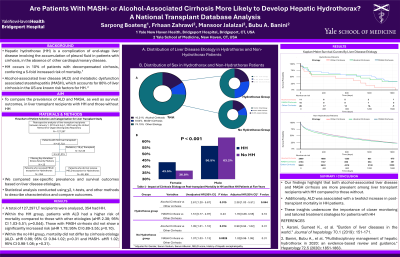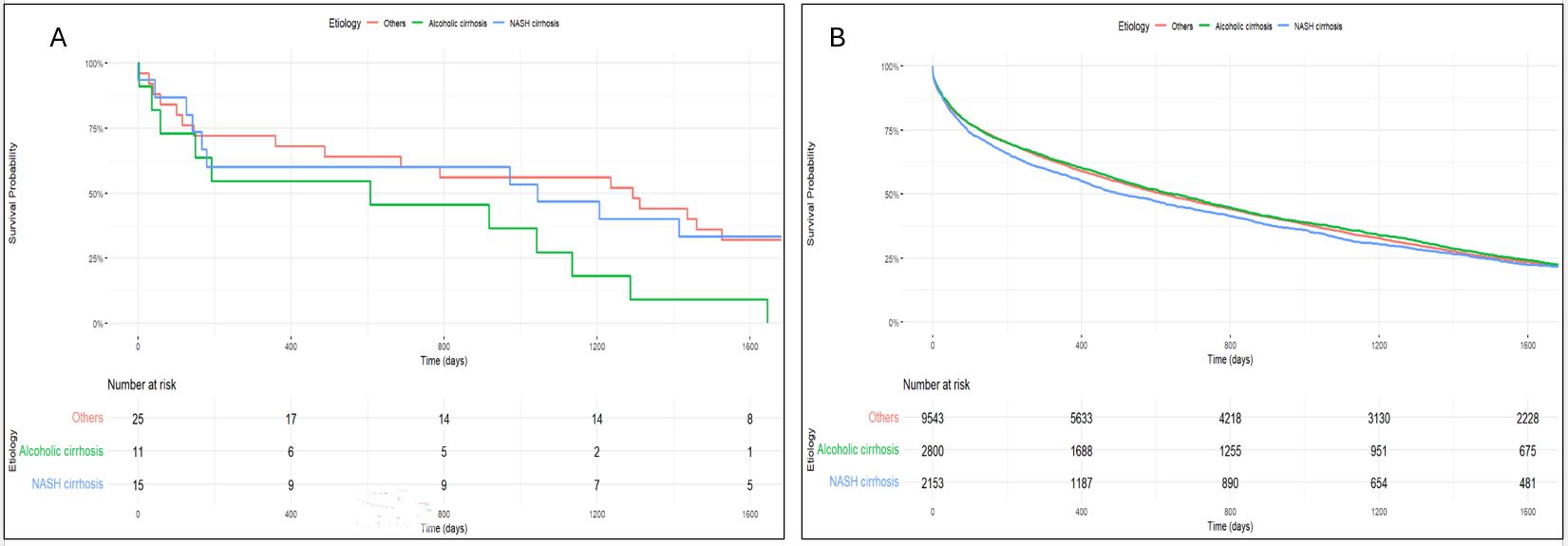Monday Poster Session
Category: Liver
P2899 - Are Patients With MASH Cirrhosis or Alcohol-Associated Cirrhosis More Likely to Develop Hepatic Hydrothorax? A National Transplant Database Analysis
Monday, October 28, 2024
10:30 AM - 4:00 PM ET
Location: Exhibit Hall E

Has Audio

Sarpong Boateng, MD, MPH
Yale New Haven Health, Bridgeport Hospital
Bridgeport, CT
Presenting Author(s)
Sarpong Boateng, MD, MPH1, Frhaan Zahrawi, MD2, Mansoor Jalalzai, MD2, Bubu Banini, MD, PhD2
1Yale New Haven Health, Bridgeport Hospital, Bridgeport, CT; 2Yale University School of Medicine, New Haven, CT
Introduction: Hepatic hydrothorax (HH) is a complication of end-stage liver disease that involves the accumulation of pleural fluid in patients with cirrhosis, in the absence of any other cardiopulmonary disease. This study compares the prevalence of alcohol-associated liver disease (ALD) and metabolic dysfunction associated steatohepatitis (MASH, previously known as NASH) in liver transplant recipients with HH vs without HH pre-transplant.
Methods: A retrospective analysis was conducted using data from the United Network for Organ Sharing database from 2012-2023. Patients were categorized into HH and no HH cohorts based on their petition for model for end stage liver disease (MELD) exception points. Individuals with diagnosis of ALD and MASH were identified among the cohorts. Proportions, confidence intervals, and p-values were calculated to determine statistical significance. Sex-specific and survival outcomes based on liver disease etiologies were also compared.
Results: A total of 127,297 liver transplant recipients were analyzed. Overall, 354 patients had HH while 126,943 had no HH. ALD prevalence was higher among patients with HH compared to no HH (22.55% vs 16.19%; p=0.0014). Similarly, MASH prevalence was higher among patients with HH (27.12% vs 9.59%; p< 0.001). Females comprised 43.50% of patients with HH compared to 36.81% of those with no HH. Females with MASH cirrhosis were over-represented in the HH group vs no HH group (59.37% vs 47.73%; p=0.03). In contrast, females with ALD were similarly represented in the HH vs no HH group (27.50% vs 28.15%; p =0.99]. Within the HH group, patients with ALD had a higher risk of mortality compared to those with other etiologies (HR 2.38; 95% CI 1.03-5.51; p=0.044). Those with MASH cirrhosis and HH did not show a significantly increased risk (HR 1.78; 95% CI 0.89-3.55; p=0.10). Interestingly, within the no HH group, adjusted HRs for mortality related to ALD and MASH cirrhosis did not differ from other etiologies (HR 0.98; 95% CI 0.94-1.02; p=0.31 and HR 1.02; 95% CI 0.98-1.08; p =0.31, respectively).
Discussion: ALD and MASH cirrhosis have higher prevalence among liver transplant candidates recipients with HH compared to those without HH, with sex-specific differences observed for MASH cirrhosis. ALD is associated with a 2-fold increase in post-transplant mortality among patients with HH, compared to other etiologies. Future research should further examine etiology- and sex-specific disparities in outcomes among persons with pre-transplant HH.

Note: The table for this abstract can be viewed in the ePoster Gallery section of the ACG 2024 ePoster Site or in The American Journal of Gastroenterology's abstract supplement issue, both of which will be available starting October 27, 2024.
Disclosures:
Sarpong Boateng, MD, MPH1, Frhaan Zahrawi, MD2, Mansoor Jalalzai, MD2, Bubu Banini, MD, PhD2. P2899 - Are Patients With MASH Cirrhosis or Alcohol-Associated Cirrhosis More Likely to Develop Hepatic Hydrothorax? A National Transplant Database Analysis, ACG 2024 Annual Scientific Meeting Abstracts. Philadelphia, PA: American College of Gastroenterology.
1Yale New Haven Health, Bridgeport Hospital, Bridgeport, CT; 2Yale University School of Medicine, New Haven, CT
Introduction: Hepatic hydrothorax (HH) is a complication of end-stage liver disease that involves the accumulation of pleural fluid in patients with cirrhosis, in the absence of any other cardiopulmonary disease. This study compares the prevalence of alcohol-associated liver disease (ALD) and metabolic dysfunction associated steatohepatitis (MASH, previously known as NASH) in liver transplant recipients with HH vs without HH pre-transplant.
Methods: A retrospective analysis was conducted using data from the United Network for Organ Sharing database from 2012-2023. Patients were categorized into HH and no HH cohorts based on their petition for model for end stage liver disease (MELD) exception points. Individuals with diagnosis of ALD and MASH were identified among the cohorts. Proportions, confidence intervals, and p-values were calculated to determine statistical significance. Sex-specific and survival outcomes based on liver disease etiologies were also compared.
Results: A total of 127,297 liver transplant recipients were analyzed. Overall, 354 patients had HH while 126,943 had no HH. ALD prevalence was higher among patients with HH compared to no HH (22.55% vs 16.19%; p=0.0014). Similarly, MASH prevalence was higher among patients with HH (27.12% vs 9.59%; p< 0.001). Females comprised 43.50% of patients with HH compared to 36.81% of those with no HH. Females with MASH cirrhosis were over-represented in the HH group vs no HH group (59.37% vs 47.73%; p=0.03). In contrast, females with ALD were similarly represented in the HH vs no HH group (27.50% vs 28.15%; p =0.99]. Within the HH group, patients with ALD had a higher risk of mortality compared to those with other etiologies (HR 2.38; 95% CI 1.03-5.51; p=0.044). Those with MASH cirrhosis and HH did not show a significantly increased risk (HR 1.78; 95% CI 0.89-3.55; p=0.10). Interestingly, within the no HH group, adjusted HRs for mortality related to ALD and MASH cirrhosis did not differ from other etiologies (HR 0.98; 95% CI 0.94-1.02; p=0.31 and HR 1.02; 95% CI 0.98-1.08; p =0.31, respectively).
Discussion: ALD and MASH cirrhosis have higher prevalence among liver transplant candidates recipients with HH compared to those without HH, with sex-specific differences observed for MASH cirrhosis. ALD is associated with a 2-fold increase in post-transplant mortality among patients with HH, compared to other etiologies. Future research should further examine etiology- and sex-specific disparities in outcomes among persons with pre-transplant HH.

Figure: Survival curves for: A- Hepatic hydrothorax patients; B-Non hepatic hydrothorax patients
Note: The table for this abstract can be viewed in the ePoster Gallery section of the ACG 2024 ePoster Site or in The American Journal of Gastroenterology's abstract supplement issue, both of which will be available starting October 27, 2024.
Disclosures:
Sarpong Boateng indicated no relevant financial relationships.
Frhaan Zahrawi indicated no relevant financial relationships.
Mansoor Jalalzai indicated no relevant financial relationships.
Bubu Banini: Boehringer Ingelheim – Advisory Committee/Board Member. Novo Nordisk – Advisory Committee/Board Member.
Sarpong Boateng, MD, MPH1, Frhaan Zahrawi, MD2, Mansoor Jalalzai, MD2, Bubu Banini, MD, PhD2. P2899 - Are Patients With MASH Cirrhosis or Alcohol-Associated Cirrhosis More Likely to Develop Hepatic Hydrothorax? A National Transplant Database Analysis, ACG 2024 Annual Scientific Meeting Abstracts. Philadelphia, PA: American College of Gastroenterology.
